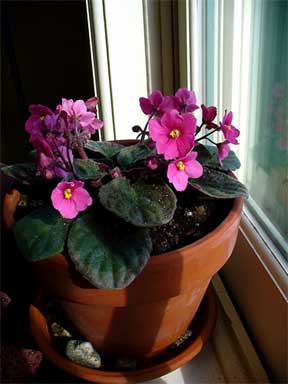Making soil for African violets when grown in any quantity can become quite a chore. And what violet lover does not have many, many plants about the house once the hobby has been established?
If you live in an apartment or small house many times it is easier to purchase potting mixes for African violets.
While repotting some orchid plants in fir bark in our fluorescent-lighted “Green Thumb Room” several months ago, I glanced at the tub of soil mix for African violets and rebelled. Why not violets in fir bark, that medium used so widely for orchid culture? And there it began. Fir bark as sold today comes from several areas of the United States. It contains the cambial layer of the tree, the nutrient bearing zone between bark and wood so rich in protein elements. It has produced remarkable root and plant growth in our orchids, and has many advantages over soil.

Nematodes, destructive to roots of African violets, fungi, insects and weed seeds are not found in the bark of firs, thereby making sterilization unnecessary. It is uniform in composition, and can be supplemented with nutrients at each mixing to meet individual needs. It holds moisture without being soggy, and for a longer period. It is much lighter to handle, clean and woodsy smelling, and can easily be spooned into pots without damage to the roots. It holds the fertilizers well and subsequent feedings can be tapered off.
The chemical composition of fir bark is roughly pH 4.3 (acid); phosphorus, medium low; potassium, medium low; nitrogen, none. Decomposition of fir bark is slow if properly watered. With this knowledge in mind, plus the fact that our tap water is alkaline, we decided to use the same nutrients in the mix as used in sterilized violet soil mix.
The mixture was made as follows: to each quart of commercial fir bark, fine or medium, was added one teaspoon steamed bone meal, one teaspoon superphosphate, one tablespoon ground eggshells, one tablespoon fine charcoal, and three tablespoons of commercially sterilized cow manure. The mixture was thoroughly moistened until one could almost squeeze out the water, then stirred until the water was well incorporated into the bark.
Dry fir bark used in a pot will resist ordinary watering and the plant will dry up. It is therefore very important to have the mixture uniformly damp, and to prevent its drying out in the pots. We feel that if the bark is kept properly damp, the water added will not run through into the saucer as is the case with soil, but will be soaked up by the moist bark.
The mixture was placed in a flat, and very young violet plants and rooted leaves were planted. A. control flat of soil mix containing same nutrients in the same proportion was planted at the same time with violets of the same age and size. Both flats were placed side by side under fluorescent lights and watered equally for about four months.
There was no addition of fertilizer to either flat during this time. At the end of the four month period the African violets in the fir bark were larger than the others, and some were in bloom. In lifting these for potting, they were found to have masses of dense root growth about four to five inches long. The fir bark was porous and springy, whereas the soil mix in the other flat had settled and packed from watering. Now, several weeks after potting, these fir bark grown violets are covered with blooms, rich in color and texture, the leaves heavy and glossy. Watering has been required less often than necessary with soil mixes.
A small pan with a rooted leaf placed in fir bark developed roots that filled the entire container and bloomed with no additional fertilizer. Two plants of the same variety of African violets were potted, the smaller of the two in fir bark, and the larger in soil. Under the same set of conditions they progressed. More nitrogenous fertilizer was added to the mixture used for the larger plants, at the rate of about 25 to 30 percent of the total volume.
Some of our larger plants, particularly the supremes, have almost doubled in size in the short time they have been in fir bark. Others have grown very large, heavy petioled leaves and long-stemmed, large, rich-hued flowers, but perhaps a bit leggy.
We are convinced from the trials made to date that and subsequent culture of African violets in fir very successfully pursued, and that this culture has many advantages to the indoor home gardener, but we will experiment further to determine the most desirable quantities of nutrients to add to the fir bark for our particular cultural circumstances in different aged plants. In all African violets in fir bark mix, however, we have seen more rapid growth and earlier more prolific blooming.
by A Hommor
